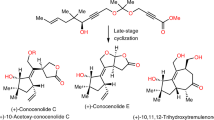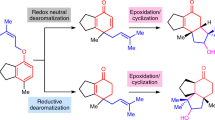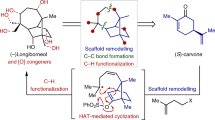Abstract
Non-stop carbocationic polycyclizations of isoprenoids have been called the most complex chemical reactions occurring in nature. We describe a strategy for the initiation of tail-to-head polycyclization that relies on the sequestration of the counteranion away from the carbocation, which allows full propagation of the cationic charge. If the anion is mobile, Coulombic forces hold this species in close proximity to the carbocation and cause preemptive termination through elimination. Anion sequestration is crucial for effecting the biomimetic synthesis of complex and unstable terpenes, including the highly strained funebrenes. This study illustrates the deleterious role of the counterion in tail-to-head carbocationic polycyclization reactions, which to the best of our knowledge has not been rigorously explored. These observations are also expected to find use in the design and control of cationic polycyclization along biosynthetic pathways that have previously been inaccessible in bulk solvent.
This is a preview of subscription content, access via your institution
Access options
Subscribe to this journal
Receive 12 print issues and online access
$259.00 per year
only $21.58 per issue
Buy this article
- Purchase on Springer Link
- Instant access to full article PDF
Prices may be subject to local taxes which are calculated during checkout






Similar content being viewed by others
References
Eschenmoser, A. Zur säurekatalysierten Zyklisierung bei Mono- und Sesquiterpenverbindungen. PhD thesis, E.T.H., Zurich (1952).
Ruzicka, L., Eschenmoser, A. & Heusser, H. The isoprene rule and the biogenesis of terpenic compounds. Experientia 9, 357–367 (1953).
Christianson, D. W. Structural biology and chemistry of the terpenoids cyclases. Chem. Rev. 106, 3142–3442 (2006).
Tantillo, D. J. Biosynthesis via carbocations: theoretical studies on terpene biosynthesis. Nat. Prod. Rep. 28, 1035–1053 (2011).
Alleman, R. K. Chemical wizardry? The generation of diversity in terpenoids biosynthesis. Pure Appl. Chem. 80, 1791–1798 (2008).
Stork, G. & Burgstahler, A. W. The stereochemistry of polyene cyclization. J. Am. Chem. Soc. 77, 5068–5077 (1955).
Eschenmoser, A., Ruzicka, L., Jeger, O. & Arigoni, D. A stereochemical interpretation of the biogenetic isoprene rule for the triterpenes. Helv. Chim. Acta 38, 1890–1904 (1955).
Snyder, S. A., Treitler, D. S. & Brucks, A. P. Simple reagents for direct halonium-induced polyene cyclizations. J. Am. Chem. Soc. 132, 14303–14314 (2010).
Ruzicka, L., Eschenmoser, A. & Heusser, H. Isoprene rule and the biogenesis of terpenic compounds. Experientia 9, 357–367 (1953).
Wendt, K. U., Schulz, G. E., Corey, E. J. & Liu, D. R. Enzyme mechanisms for polycyclic triterpene formation. Angew. Chem. Int. Ed. 39, 2812–2833 (2000).
Lodeiro, S. et al. An oxidosqualene cyclase makes numerous products by diverse mechanisms: a challenge to prevailing concepts of triterpene biosynthesis. J. Am. Chem. Soc. 129, 11213–11222 (2007).
Johnson, W. S. Biomimetic polyene cyclizations. Angew. Chem. Int. Ed. 15, 9–17 (1976).
Yoder, R. A. & Johnston, J. J. A case study in biomimetic total synthesis: polyolefin carbocyclizations to terpenes and steroids. Chem. Rev. 105, 4730–4756 (2005).
Corey, E. J. & Staas, D. D. Demonstration of a common concerted mechanistic pathway for the acid-catalyzed cyclization of 5,6-unsaturated oxiranes in chemical and enzymatic systems. J. Am. Chem. Soc. 120, 3526–3527 (1988).
Kronja, O., Orlovic, M., Humski, K. & Borcic, S. Lack of a secondary β-deuterium kinetic isotope effect in the solvolysis of 2-chloro-3-hydrosqualene. A case of extended π-participation and indication of concerted biomimetic polycyclization. J. Am. Chem. Soc. 113, 2306–2308 (1991).
Li, B., Tan, L.-J. S., Shen, Z.-L. & Loh, T.-P. Enantioselective cationic polyene cyclization vs enantioselective intramolecular carbonyl–ene reaction. J. Am. Chem. Soc. 132, 10242–10244 (2010).
Knowles, R. R., Lin, S. & Jacobsen, E. N. Enantioselective thiourea-catalyzed cationic polycylizations. J. Am. Chem. Soc. 132, 5030–5032 (2010).
Semmler, F. W. & Spornitz, K. E. On knowledge of the constituents of essential oils (announcement on the sesquiterpene fraction of java-citronella-oil). Chem. Ber. 46, 4025–4029 (1913).
Gutsche, C. D., Maycock, J. R. & Chang, C. T. Acid-catalyzed cyclization of farnesol and nerolidol. Tetrahedron 24, 859–876 (1968).
Ohta, Y. & Hirose, Y. Electrophile induced cyclization of farnesol. Chem. Lett. 263–266 (1972).
Kobayashi, S., Tsutsui, M. & Mukaiyama, T. Biogenetic-like cyclization of farnesol and nerolidol to bisabolene by the use of 2-fluorobenzothazolium salt. Chem. Lett. 10, 1169–1172 (1977).
Sakane, S., Fujiwara, J., Maruoka, K. & Yamamoto, H. Chiral leaving group. Biogenetic-type asymmetric synthesis of limonene and bisabolenes. J. Am. Chem. Soc. 105, 6154–6155 (1983).
Andersen, N. H. & Syrdal, D. D. Chemical simulation of the biosynthesis of cedrene. Tetrahedron Lett. 24, 2455–2458 (1972).
Polovinka, M. P. et al. Cyclization and rearrangements of farnesol and nerolidol stereoisomers in superacids. J. Org. Chem. 59, 1509–1517 (1994).
Polovinka, M. P. et al. Molecular rearrangements of (–)-α-cedrene in superacids. Tetrahedron Lett. 36, 8093–8096 (1995).
Reed, C. A. Carborane acids. New ‘strong yet gentle’ acids for organic and inorganic chemistry. Chem. Commun. 1669–1677 (2005).
Xu, M., Wilderman, P. R. & Peters, R. J. Following evolution's lead to a single residue switch for diterpene synthase product outcome. Proc. Natl Acad. Sci. USA 104, 7397–7401 (2007).
Corey, E. J. & Sodeoka, M. An effective system for epoxide-initiated cation-olefin cyclization. Tetrahedron Lett. 32, 7005–7008 (1991).
Lehmkuhl, H. & Kobs, H.-D. Untersuchungen uber die elektrolytische Dissoziation yon Alkylaluminium-Donator-Verbindungen. Liebigs Ann. Chem. 729, 11–19 (1968).
Evans, D. A., Allison, B. D. & Yang, M. G. Chelate-controlled carbonyl addition reactions. The exceptional chelating ability of dimethylaluminum chloride and methylaluminum dichloride. Tetrahedron Lett. 40, 4457–4460 (1999).
Snider, B. B., Rodini, D. J. & van Straten, J. Lewis acid induced conjugate addition of alkenes to α,β-unsaturated ketones or aldehydes. J. Am. Chem. Soc. 102, 5872–5880 (1980).
Snider, B. B., Karras, M., Price, R. T. & Rodini, D. J. Alkylaluminum halide induced cyclization of unsaturated carbonyl compounds. J. Org. Chem. 47, 4538–4545 (1982).
Brun, P. Synthesis of alpha-biotol and alpha-epibiotol. Tetrahedron Lett. 26, 2269–2272 (1977).
Beauchamp, P. S. et al. California lomatiums, Part IVa: Composition of the essential oils of Lomatium rigidum (M.E. Jones) Jepson. Structures of two new funebrene epimers and a tridecatriene. J. Essent. Oil Res. 16, 571–578 (2004).
Brown, G. D., Liang, G.-Y. & Sy, L.-K. Terpenoids from the seeds of Artemisia annua. Phytochemistry 64, 303–323 (2003).
Stork, G. & Clarke, F. H. Jr. Cedrol: stereochemistry and total synthesis. J. Am. Chem. Soc. 83, 3114–3125 (1961).
Tomita, B. & Hirose, Y. Allo-cedrol: a new tricarbocyclic sesquiterpene alcohol. Phytochemistry 12, 1409–1414 (1973).
Cool, L. G. Sesquiterpenes from Cupressus macrocarpa foliage. Phytochemistry 66, 249–260 (2005).
Sy, L.-K. & Brown, G. D. A sesquiterpene class from Illicium dunnianum. Phytochemistry 47, 301–302 (1998).
Shenvi, R. A. & Corey, E. J. Synthetic access to bent polycycles by cation-π cyclization. Org. Lett. 12, 3548–3551 (2010).
Acknowledgements
The authors thank R. Mohan of Exelixis for the very generous donation of supplies and chemicals, and C. Moore and A. Rheingold for crystal X-ray diffraction data. The authors also thank J. Sears for technical assistance. Financial support was provided by the Scripps Research Institute (Novartis ADI Grant) and Eli Lilly.
Author information
Authors and Affiliations
Contributions
S.V.P. and R.A.S. contributed equally to the work.
Corresponding author
Ethics declarations
Competing interests
The authors declare no competing financial interests.
Supplementary information
Supplementary information
Supplementary information (PDF 5408 kb)
Rights and permissions
About this article
Cite this article
Pronin, S., Shenvi, R. Synthesis of highly strained terpenes by non-stop tail-to-head polycyclization. Nature Chem 4, 915–920 (2012). https://doi.org/10.1038/nchem.1458
Received:
Accepted:
Published:
Issue Date:
DOI: https://doi.org/10.1038/nchem.1458
This article is cited by
-
Biomimetic tail-to-head terpene cyclizations using the resorcin[4]arene capsule catalyst
Nature Protocols (2024)
-
Advances in supramolecular host-mediated reactivity
Nature Catalysis (2020)
-
Synthesis of bridged tricyclo[5.2.1.01,5]decanes via nickel-catalyzed asymmetric domino cyclization of enynones
Nature Communications (2020)
-
Broadening the scope of biocatalytic C–C bond formation
Nature Reviews Chemistry (2020)
-
Total synthesis of terpenes via palladium-catalysed cyclization strategy
Nature Chemistry (2020)



